How to Write a Teacher Cover Letter (+ Examples)
Writing a compelling teacher cover letter is crucial to make a positive first impression on a potential employer. See how to impress a principal using this comprehensive guide.
Our customers were hired by:
A cover (or covering) letter is not an optional extra to send along with your CV, it’s fully half of your job application. It’s true that some employers will ask you not to send a cover letter. But if you were applying to one of those you probably wouldn’t be looking up how to structure a cover letter.
Like any piece of formal writing, getting the structure of a cover letter right is half the battle. Knowing what to write isn’t enough—how you write it is also critical. Luckily, these two aspects of writing—the what and the how—are linked in such a way that knowing the how makes sorting out the what easier.
This article is here to make getting the structure of your cover letter right as simple as possible. Follow along with clear instructions, nuts-and-bolts breakdowns, and UK-specific cover letter structure examples to have your cover letter mapped out and ready to write in no time.
Use the LiveCareer cover letter builder and your cover letter will write itself. Choose a professional template, answer a few easy questions and the creator will generate a professional cover letter for you with just one click.
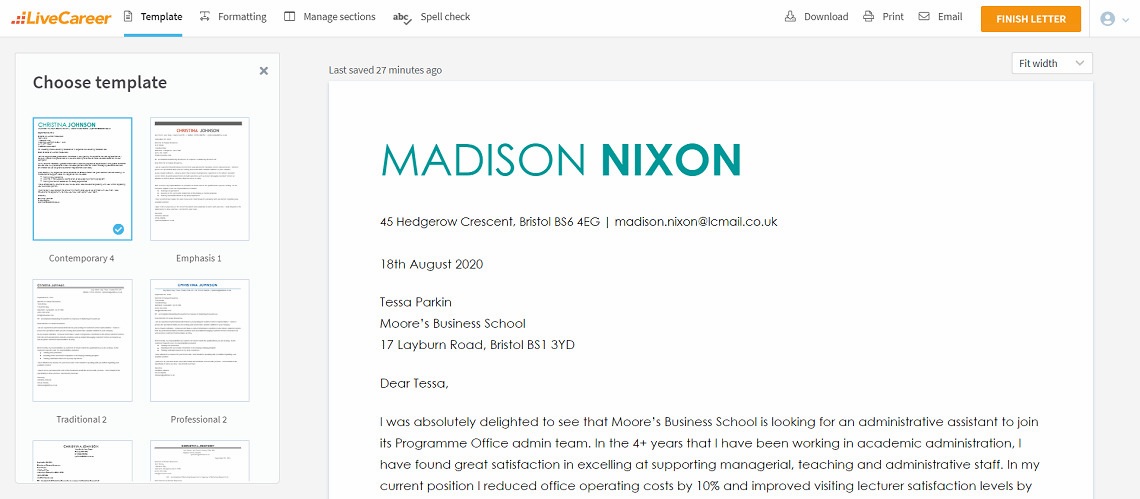
Seeking more expert tips on cover letter writing? See these guides:
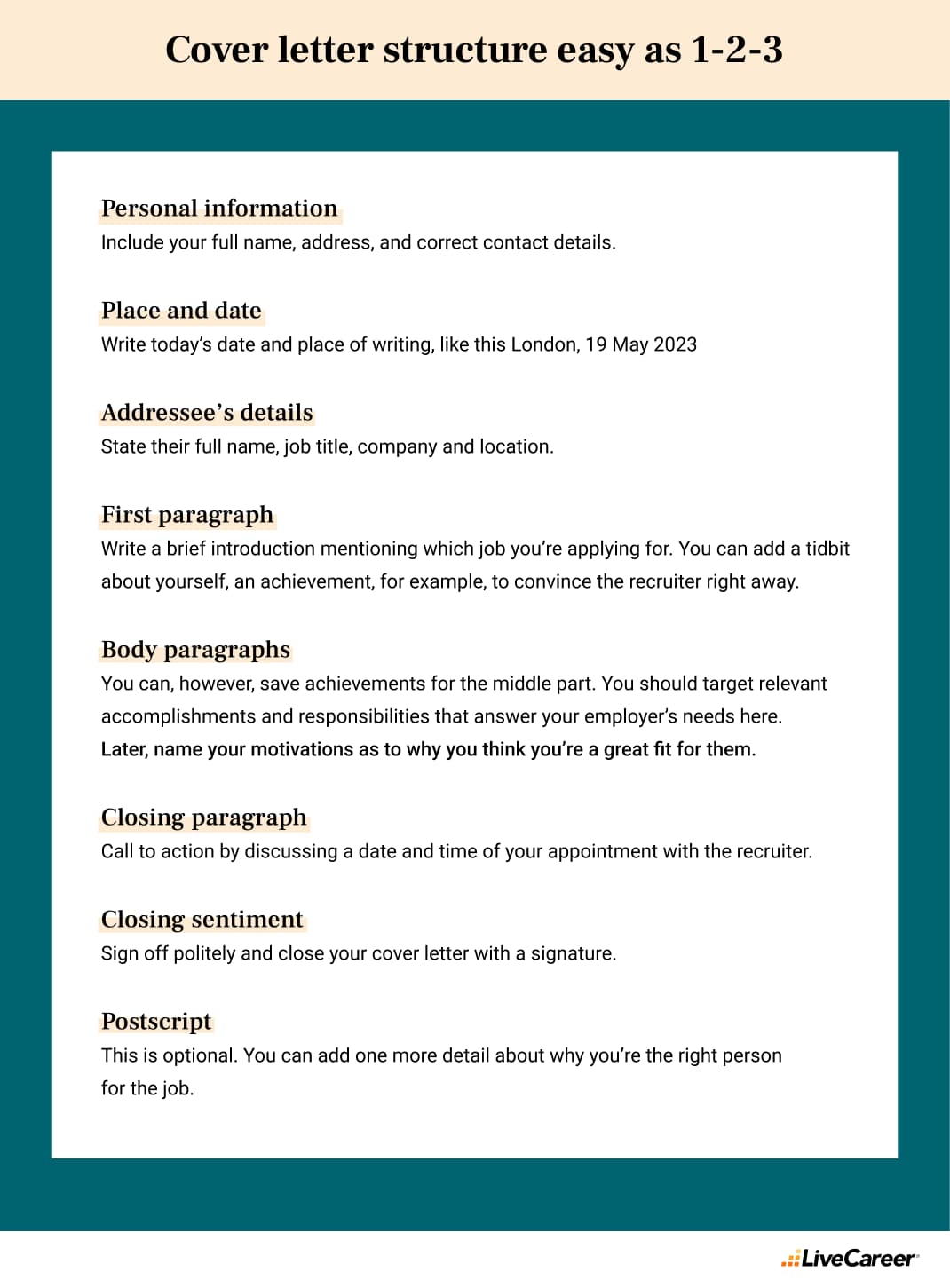
To actually go about structuring your cover letter, think of the business letter format as a recipe. The first thing you’ll need to do is gather up all the necessary ingredients. For the header, you’ll need:
The salutation is easy, you’ll already have the addressee’s name or position. Of course, the content of the body of your cover letter isn’t laid out by the standard business letter format, but you’ll need:
And, finally, the way you sign off will be determined by the salutation you used, so you’ll have everything you need there, too.
Fleshing out each of these parts and getting recruiters to give you a call is something that’s easier said than done, though. A good cover letter structure will give you a strong foundation. Check out a cover letter writing guide for plenty of examples and advice on how to build on that foundation.
You can adjust every cover letter created in the builder to meet the job requirements. Choose the name of your profession and the company to which you’re applying, and the LiveCareer cover letter builder will automatically adapt the content for you. Create a cover letter faster than you ever thought possible and apply for the job in record time.
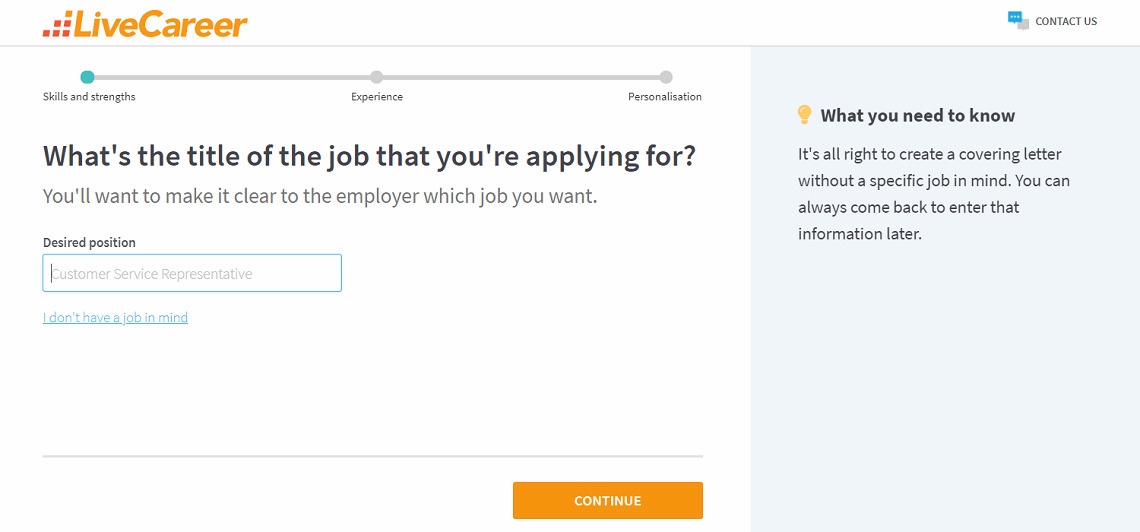
How to address a cover letter? A ‘standard business letter’ is going to look different from country to country. Cover letters (or motivation letters)—being a type of business letter—are no exception. Cover letter structure can vary according to whose contact details go where, whether they’re left- or right-aligned, or the salutation used, to name just a few.
The header is perhaps where such regional differences are most pronounced. Have a look at the header example below and note the justification (alignment) used as well as how the date is written and where it’s placed. All British letters should follow this pattern but it’ll vary in other parts of the world.
Take note also of the fact that the sender’s details include a phone number and an email address. This may not strictly be part of the standard British business letter format but makes sense as part of a cover letter’s structure—you want recruiters to be able to contact you as easily as possible.
Madison Nixon
45 Hedgerow Crescent
Bristol
BS6 4EG
077 6666 7777
madison.nixon@lcmail.co.uk
18th August 2021
Tessa Parkin
Human Resources Manager
Moore’s Business School
17 Layburn Road
Bristol
BS1 3YD
Following the standard UK business letter format, you should stick with a standard, formal salutation. ‘Dear’ + the first name of the person to whom you’re writing is generally the best option. ‘Dear’ + the person’s title and surname is another option, as is ‘Dear’ + the person’s full name (avoid this if possible).
Dear Tessa,
The first paragraph of your letter of application is where you’ll make your first impression. In order to really grab your reader’s attention and make them sit up and pay attention, your opening paragraph will need to do these three things well:
I was absolutely delighted to see that Moore’s Business School is looking for an administrative assistant to join its Programme Office admin team. In the 4+ years that I have been working in academic administration, I have found great satisfaction in excelling at supporting managerial, teaching and administrative staff. In my current position I reduced office operating costs by 10% and improved visiting lecturer satisfaction levels by over 40%.
You don’t have to create any content yourself. The LiveCareer cover letter generator will automatically suggest the best content for your cover letter with ready-made examples and expert tips.
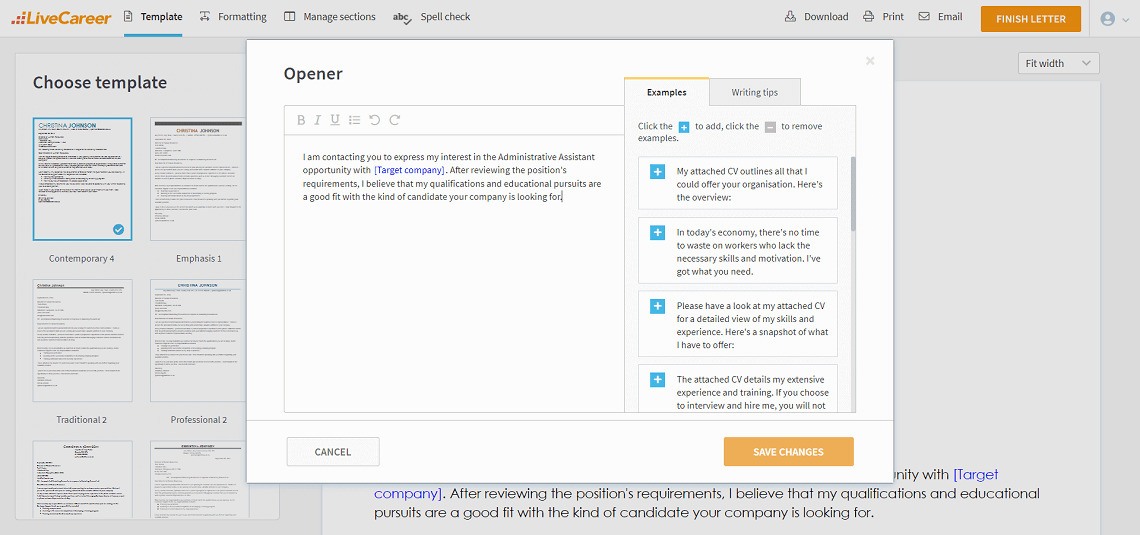
This is where you’ll have the opportunity to showcase your achievements in the workplace thus far. The trick to making this as compelling as possible and standing out from the crowd is quantifying each and every achievement. This means putting numbers to your claims and backing them up with facts.
An achievement in this case is a description of actions you took and the benefits that they brought to your employer. Quantify everything you can, but focus on putting numbers to the benefits you brought your employers above all else. Estimating impacts is totally fine and often necessary.
In my current role at Griffiths College I successfully sorted through 14 years of old student records, reducing stored paperwork by 45% and freeing up significant archive space all while working strictly within college policies and GDPR requirements. I also switched office supply vendors, saving the college over £300 per month in purchase and delivery costs while changing to a more convenient delivery model. In my previous role with the Sands Institute of Technology, I did some research regarding hotels in the area and secured a preferential rate for SIT to host its guest lecturers and other VIP visitors, allowing SIT to offer its guests an even higher standard of accommodation while saving 5–15% on accommodation and taxi costs.
The closing paragraph, like the name suggests, aims to wrap all your achievements up and tie up any loose ends. This is not the place to introduce new information, but rather to summarise what came before. It’s a great opportunity to show off some additional knowledge about the company.
Good cover letters will include a quick expression of gratitude to the recruiter for the time and energy they’ve put into considering the application. They’ll also end on a confident Call to Action (CTA), expressing the desire to elaborate further on what the CV and cover letter contain during an interview.
As you can see, I take the initiate whenever I can and enjoy making myself useful in ways that go beyond core administrative tasks like dealing with daily correspondence and enquiries and preparing and filing documentation. Given how small MBS’s admin team is, I think this a quality that could be very beneficial to the School.
Thank you for your consideration. I look forward to discussing my CV in greater detail during the course of an interview.
The standard UK business letter format limits the options for ways to sign off at the end of a formal letter like a cover letter. Letters that were addressed to a specific, named person end with ‘Yours Sincerely’ whilst letter that were addressed to an unnamed recipient end with ‘Yours Faithfully’.
Your Sincerely,
Madison Nixon
Following a good cover letter structure should leave you with a cover letter that’s between half an A4 page and a full A4 page long. A two-page cover letter is too long. A total of around 250–400 words, including the header, salutation, sign-off and body paragraphs:
There’s cover letter structure and then there’s cover letter format and layout. Keep the following things in mind when putting the finishing touches on your perfect cover letter:
Stuck on writing your cover letter? Try using AI for tips and inspiration.
A cover letter alone simply won’t be enough—you need an impactful CV, too. Create your CV in minutes. Just follow our wizard and fill in every CV section with ready-made content. Get started by choosing a professional CV template.
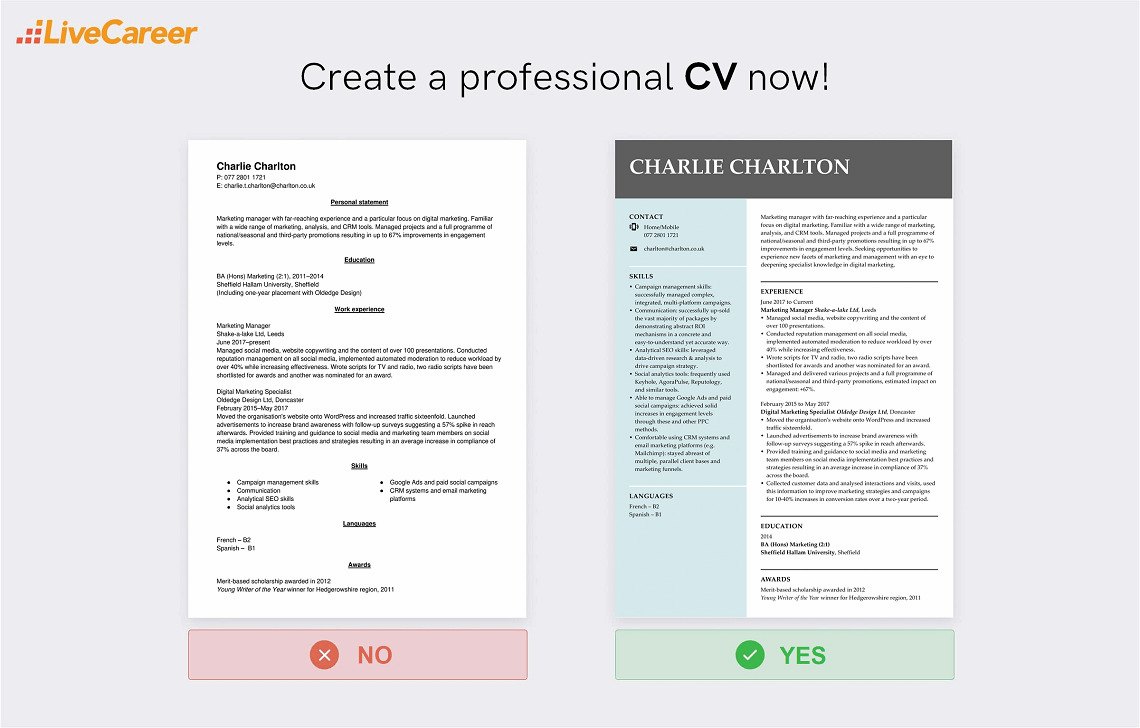
Has this article helped you get your head around cover letter structure? Please leave any questions, comments and feedback in the comments section below.
Our editorial team has reviewed this article for compliance with Livecareer’s editorial guidelines. It’s to ensure that our expert advice and recommendations are consistent across all our career guides and align with current CV and cover letter writing standards and trends. We’re trusted by over 10 million job seekers, supporting them on their way to finding their dream job. Each article is preceded by research and scrutiny to ensure our content responds to current market trends and demand.
About the author
Since 2013, the LiveCareer UK team has shared the best advice to help you advance your career. Experts from our UK editorial team have written more than one hundred guides on how to write the perfect CV or cover letter.
Rate this article:
Cover letter structure
Average:
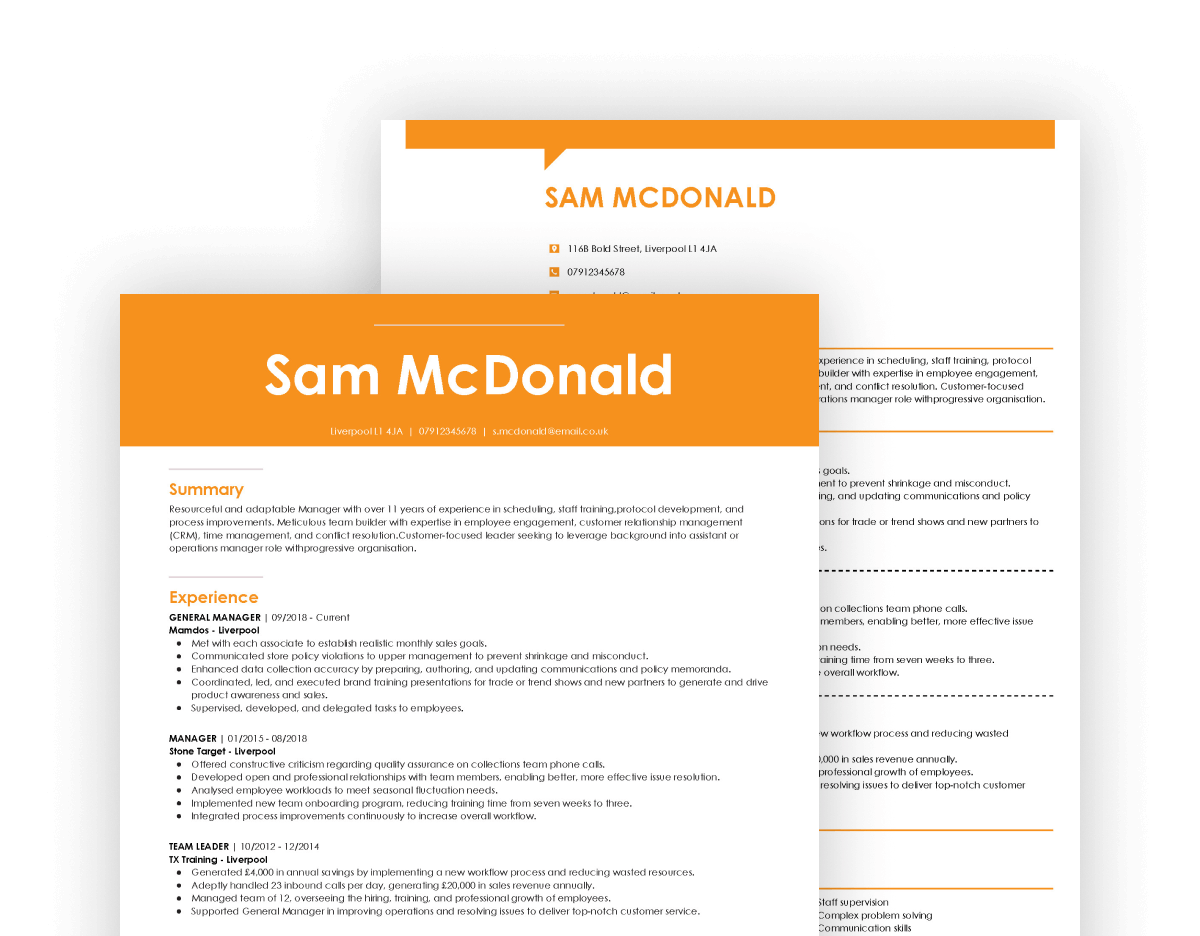
Writing a compelling teacher cover letter is crucial to make a positive first impression on a potential employer. See how to impress a principal using this comprehensive guide.
What to include in a warehouse operative cover letter? Use our cover letter for a warehouse operative with expert tips and examples to land a job.
Your receptionist cover letter is the front desk to your career. Learn how to write an effective cover letter for a receptionist with examples here.
Our customers were hired by: